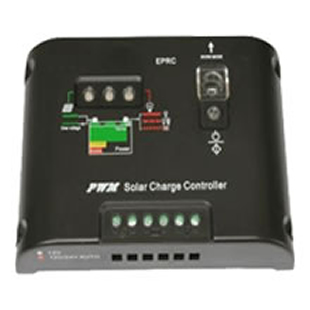
Charge Regulator
 The main task of the charge regulator is to charge the batteries and protect them from high discharge. The charge regulator electron is very sensitive and very important for guaranteeing stable photovoltaic system operation. The disruption of the charge regulator may require battery replacement and the maintenance cost is very high. Charge The efficiency percentage of the regulator is an important parameter to consider.
The main task of the charge regulator is to charge the batteries and protect them from high discharge. The charge regulator electron is very sensitive and very important for guaranteeing stable photovoltaic system operation. The disruption of the charge regulator may require battery replacement and the maintenance cost is very high. Charge The efficiency percentage of the regulator is an important parameter to consider.
The charge controller functions are switched on to monitor simple type battery voltage and stop charging when the circuit voltage reaches a certain level. Old charge controllers were built using a mechanical relay to switch the circuit on and off. Today, charge controllers use pulse width modulation (PWM). The battery is a process that reaches fully charged stoppage. As power is transferred, the amount of power gradually decreases. PWM reduces battery stress and extends battery life further. Battery can also be fully charged or indefinitely variable. PWM charging is more complex, but it is more durable than without any frangible mechanical connections. Use the most popular type of solar charge regulator, follow the max power point, or use MPPT. MPPT converts overvoltage to amp.
The majority of solar energy systems are not 12-volt batteries, unlike automobiles, but they work regardless of voltage. The panel provides more voltage than the battery. When converted to an overvoltage amp, the time required to fully charge the battery is reduced and the charge voltage is optimized It remains. A solar energy system using such a charge controller will perform more efficiently.
Power loss also reduces the efficiency of the MPPT charge controllers. In a home system, power travels from device to device along all electrical wires and power is lost at a certain amount during this process. High voltage electrical current is less lost. The power used by a PWM charge regulator used with a 12v battery is often around 18v. The MPPT controller uses the highest voltage available at the charge reflex. MPPT controllers therefore lose less power.
Compared to PWM controllers, MPPT charge controllers are a little more expensive, but MPPT performance has improved significantly. For that reason, it is highly recommended. Reverse current can be avoided with some modern charge controllers. The solar panels stop generating electricity when there is no sun, and this time they start to send out the electric power. The charge regulator opens the electrical circuit to prevent any reverse current flow when it stops sending electricity from the solar panels. A 12 volt solar charger is a surprisingly simple and useful alternate for individuals who want to reduce costs and emissions, and to remove energy dependency from abroad.
